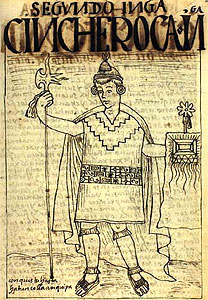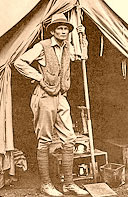|
Hiram Bingham, the American explorer who found the
ruins of Machu Picchu in 1911, wrote:
Among the Incas,
practically every man was married at least
once. Polygamy was general among the upper
classes and was regarded as a desirable
state for those who could afford it. The
Inca rulers, the nobles and distinguished
military leaders, were awarded concubines.
They were usually taken from one of the
national boarding schools or convents, where
attractive young girls or Chosen Women,
selected annually from all over the empire,
were trained.
These Chosen
Women, whose lives were consecrated to the
service of the Sun, his representatives, the
Incas and his priests, lived in sanctuaries
which were scattered throughout the Inca
Empire. It was deemed a great honor to a
newly conquered province for the Inca to
establish one within its borders.
|

The second Inca, Sinchi Roca Inca.
Illustrations from 1615 by
The "Indian Chronicler" Felipe Guaman Poma. |
According to the
Spanish conquerors, the most important
convent was at Cuzco adjoining the Temple of
the Sun. Other women were forbidden to enter
that holy place. Men were not allowed in the
royal boarding schools. The most beautiful
and best born maidens in each province
appear to have been selected early in life
when eight or nine years old. They were
supervised by older women who had lived for
years in the convents. The girls learned not
only to weave skillfully the clothing worn
by the nobles as well as the beautiful robes
and elaborate hangings used on state
occasions, they were also taught the
preparation of special foods and beverages
used in great ceremonials. Apparently the
girls were kept in the convents until they
were about sixteen years old age, when they
were divided into three classes based on
their degree of beauty. Probably the most
beautiful and highly born became concubines
of the Inca Emperor himself. It is believed
that some were selected to be sacrificed in
honor of the sun, or at all events, to be
interned for life in one of the convents
where they could act also as temple
attendants and as instructors of the Chosen
Girls. A third group seems to have been
given by the emperor as wives to nobles or
military captains whom he wished
particularly to favor.
It was natural
that the most desirable girls should be set
aside for the worship of the sun, whom the
Incas regarded as a benevolent and
life-giving god. In the Andes, one is rarely
comfortable except when the sun is shining.
It is not surprising, therefore, that the
worship of the sun involved such elements as
propitiation supplication and thanksgiving.
It was important that the priests should be
served by the most attractive young women of
the kingdom.
|

Chosen Women or Virgins of the Sun.
Illustrations from 1615 by
The "Indian Chronicler" Felipe Guaman Poma. |
Our knowledge of
the Chosen Women, or, Virgins of the Sun, is
derived, in part, from the writings of Cieza
de Leon, the greatest and most illustrious
of the contemporary historians of the period
of conquest. He say that at the doors of the
convents porters were stationed to keep
guard over the virgins many of whom were of
noble birth, besides being beautiful and
charming. He says that if one of them had
any connection with a man she was killed by
being buried alive and the same penalty was
suffered by her paramour.
One of his
contemporaries, Polo de Ondegardo, says that
the convents were called aclla-huasi,
meaning “the house of the Chosen Ones,” He
says they were selected by the governors in
the provinces who had the power to choose
girls of the proper age without limit as to
the number chosen. Their teachers were
called mama-cunas.
He says the
number of women set apart for this purpose
was very great and their parents could not
excuse or redeem them under any
circumstances. Estates were set apart for
the support of the convents.
He says,
further, that great quantities of the cloth
made in the convents were distributed among
the Inca’s favorite soldiers and given to
his relations and attendants. Also enormous
quantities were deposited in storehouses to
be used as needed.
Source:
‘Lost City of the Incas, The Story of Machu
Picchu and its Builders’ by Hiram Bingham
The American explorer who found the ruins of Machu Picchu in 1911.

Hiram Bingham at Machu Picchu
The inspiration for Indiana Jones?
Source:
Illustrations:
Guaman Poma - 'El primer Nueva
corónica y buen gobierno'. |